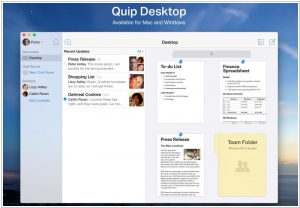Amazon WorkDocs vs Quip
August 26, 2023 | Author: Michael Stromann
8

Amazon WorkDocs is a fully managed, secure enterprise storage and sharing service with strong administrative controls and feedback capabilities that improve user productivity. Users can comment on files, send them to others for feedback, and upload new versions without having to resort to emailing multiple versions of their files as attachments. Users can take advantage of these capabilities wherever they are, using the device of their choice, including PCs, Macs, and tablets.
See also:
Top 10 Cloud Storages for business
Top 10 Cloud Storages for business
Amazon WorkDocs and Quip are both cloud-based collaboration platforms, but they have distinct focuses and features. Amazon WorkDocs is a document management and collaboration tool designed for businesses. It provides features such as secure file storage, document sharing, real-time collaboration, version control, and granular permissions. WorkDocs integrates well with other Amazon Web Services (AWS) products, making it suitable for organizations already using AWS infrastructure. Quip, on the other hand, offers a broader collaboration platform that combines documents, spreadsheets, chat, and project management features. It emphasizes real-time collaboration, team communication, and task management. Quip is known for its user-friendly interface and mobile accessibility.
See also: Top 10 Cloud Storages
See also: Top 10 Cloud Storages
Amazon WorkDocs vs Quip in our news:
2016. Salesforce buys collaborative word processing app Quip

Salesforce has made a significant acquisition of the cloud-based word processing app, Quip, for a whopping $750 million. Under Salesforce's ownership, Quip will retain its operational autonomy. Quip initially gained recognition as a disruptive force in the industry when it launched as a mobile-only native app (though it now offers desktop and web versions) and posed a formidable challenge to the established Microsoft Word. Salesforce's acquisition of Quip not only bolsters its existing portfolio of productivity services but also presents an opportunity to entice more customers away from Microsoft's offerings. The price paid for the acquisition, coupled with the inclusion of the Quip team as part of the deal, suggests that Salesforce may have grander plans in mind beyond simply offering Quip as it is.
2015. Amazon released mobile app for Cloud Drive
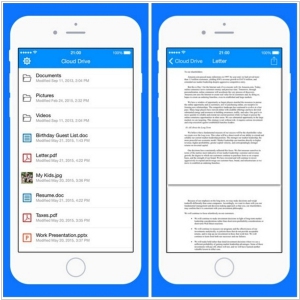
Amazon has launched a specialized mobile application that grants users access to their stored documents within the Cloud Drive service. This release is a response to the growing competition within the cloud storage market, where companies like Google and Dropbox dominate. The newly introduced app is compatible with iOS, Android, and Kindle devices, enabling users to conveniently view all their documents stored in their Amazon Cloud account. The accessibility extends to any location where users are logged in. Additionally, the app serves as a complementary tool to the existing desktop cloud client. With this mobile app, users can now browse their files, much like using a desktop's file browser, similar to the functionality offered by the Dropbox app.
2015. Amazon Cloud Drive adds unlimited storage plan

Amazon Cloud Drive is expanding its services to include a paid offering that encompasses a wide range of content and is available to users outside of its loyalty program. With Unlimited Cloud Storage, users can opt for either unlimited photo storage or an "unlimited everything" plan, which covers various media types such as videos, music, and PDF documents. The pricing for these plans is set at $11.99 per year for unlimited photo storage and $59.99 per year for the comprehensive "unlimited everything" option. This strategic move by Amazon is a direct response to the competition posed by established players like Dropbox, Google, Microsoft, and other prominent providers in the increasingly crowded market for cloud-based storage services. While Amazon is not the first to offer "unlimited" storage, it appears to be the first to market this service to anyone who desires it.
2014. Amazon adds new syncing feature to enterprise cloud storage Zocalo
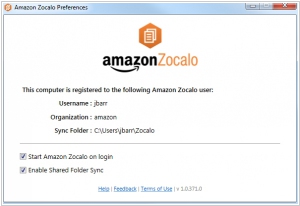
Amazon's Zocalo work-collaboration tool, which rivals services such as Dropbox and Box, has introduced a new functionality that enables the synchronization of files to your computer or mobile device via a shared folder. Users can establish project-specific folders and selectively share them with members of their project team whenever necessary. Once a shared folder is set up, team members gain access to the documents within, and any modifications made and saved to the files are recorded by Zocalo. The syncing feature is optional and can be activated in the preferences section of the Zocalo client, should users desire to utilize it.
2014. Amazon Cloud Drive gets API
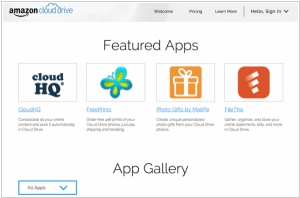
Amazon has announced the launch of the Cloud Drive API, enabling third-party developers to seamlessly integrate Cloud Drive into their own applications. This integration allows developers to focus on enhancing their app's core functionalities rather than dealing with the complexities associated with storage, such as screen resolutions, metadata management, indexing, search, or sync functionality. While developers have been utilizing Amazon Web Services for some time, the Cloud Drive API specifically caters to incorporating consumer-oriented features into applications. For example, a photo-editing app could offer users the ability to browse and edit photos stored on Amazon Cloud Drive. Several mobile applications, including OfficeSuite, Perfectly Clear, FreePrints, Photo Gifts by MailPix, ScanCafe, FileThis, CloudHQ, File Commander, Jumptuit, Secrata, and Wappwolf, have already integrated Cloud Drive's API upon its launch.
2014. Amazon launched enterprise file-sharing service Zocalo
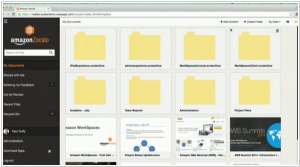
Amazon has set its sights on Microsoft, Google, and Box with the introduction of their new enterprise file-sharing service called Amazon Zocalo. Built on the foundation of Amazon Web Services, Zocalo offers a fully managed and secure document storage and sharing service tailored specifically for the requirements of businesses. Zocalo features centralized user management and has the capability to integrate with existing Active Directory systems. This is a significant development as traditional cloud-based document solutions like Dropbox often lack the granularity needed to align with stringent IT policies. Amazon emphasizes that all documents transmitted through Zocalo are encrypted for enhanced security. The service provides client syncing applications for both Windows and Mac, allowing for seamless folder synchronization. Additionally, Zocalo offers dedicated apps for iPad, Kindle Fire, and Android tablets. The pricing for Zocalo is set at $5 per user per month, providing 200GB of storage space.
2013. Amazon wants to kill Dropbox
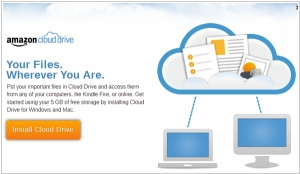
Two years ago, Amazon launched its online storage service called Amazon Cloud Drive. It quickly caught attention due to its generous free limits (5 GB storage and 2 GB maximum file size) and the inclusion of a built-in media player. However, it fell short of causing a revolution because it was limited to browser usage and lacked file sharing and sync capabilities between computers. Fortunately, Amazon has addressed these limitations. Amazon Cloud Drive now offers dedicated agents for both Windows and Mac platforms, allowing file synchronization between computers and enabling users to share files with others. Additionally, the service continues to provide 5 GB of free storage (with a 2 GB file size limit), and for 20 GB of storage, users only need to pay $10 per year. This leads to the question: what will happen to Dropbox? If Amazon takes the initiative and releases Cloud Drive mobile apps for iOS and Android, Dropbox could become an unnecessary intermediary. It's worth noting that Dropbox relies on Amazon S3 as its storage infrastructure, essentially reselling Amazon's resources. Furthermore, Dropbox can't compete with Amazon in terms of pricing and reliability.
2011. Amazon Cloud Drive vs. Microsoft SkyDrive vs. Google Docs vs. Box.net
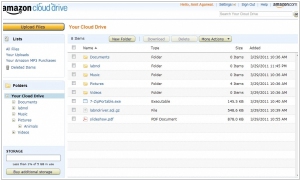
Last week, Amazon launched the new online file storage service Amazon Cloud Drive. And taking into account reputation of Amazon, as the online storage market leader, this event, of course, deserves our attention. Let's consider the advantages and disadvantages of this service compared to key competitors. The main parameters - are shown in the table (below). It's turns out that the main advantage of Amazon Cloud Drive - if free 5GB account with maximum file size of 2GB. However, its main drawback negates this advantage: you can not share this large file with anyone. Amazon Cloud Drive doesn't allow to share files publicly or protected by password. I.e. the only way of using this service - is a private storage for backup or enhancing your productivity. ***

